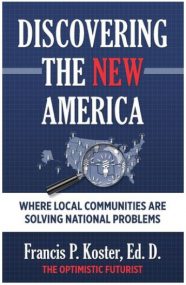Welcome to America's Optimistic futurist
Proven ways to improve kids' learning
without messing with teachers.

Need a Partner? Try the U.S. Department of Energy's Teaming Partner List.
Energy costs too high at your school? Learn about DOE's Qualified List of Energy Service Co's.
NEW Subscriber?
Find Past Newsletters of interest, below!
Newsletter of the Week
NORTH CAROLINA PUBLIC SCHOOL FORUM has published a powerful article about the September, 2023, expansion of the Opportunity Scholarship Program ("voucher" program).
Appearing in many North Carolina newspapers, the article, published June 13, 2024, by The North Carolina Public School Forum provides a comprehensive summary of this controversial subject.
Even before the General Assembly reduced the state's public school budget to expand vouchers, North Carolina held the following national ranks:
- 48th in per-student spending;
- 49th on funding effort--the amount we spend on education as a percentage of our state's GDP; and
- 38th in average teacher pay, falling nearly $13,000 below the national average.
The Public School Forum of North Carolina conducted research on the 200 schools that had previously received the most taxpayer funds from school vouchers through the Opportunity Scholarship Program:
- Only 8.5 percent of the private schools receiving vouchers report standardized testing scores on their websites
- Only 2 percent of private schools required their teachers to be certified by the state
- 90 percent of the top voucher-receiving schools were religious, and 68 percent had religious requirements for admission
- 38 percent excluded Students with Disabilities from admission
Read the full text of Elizabeth Paul's article,
School Choice? Or Schools' Choice?.
New Approach to an Old Problem
Do you work for a school district or a state educational agency that wants to try new things?
Would you like to implement evidence-based, field-initiated innovations that improve academic performance, attract and retain great teachers, increase access to STEM curricula, and address students’ social and emotional needs? Our sister organization, The Pollution Detectives, Inc., is seeking partners in innovation to apply for the federal government’s Education Innovation and Research Early Phase Grant. TPD assists schools in raising student learning by promoting environmental health for students and teachers.
If you would like to learn more about how your school can benefit, click on the links above (Funding Opportunity 1., below) and contact Dr. Francis P. Koster at fkoster@theoptimisticfuturist.org or 904-616-8024. We look forward to hearing from you!
Worth a Second Look
White House Summit on Sustainable and Healthy K-12 School Buildings and Grounds
(Video; 2:34:59)
On April 26, 2024, the White House held its first-ever Summit for Sustainable and Healthy K-12 Infrastructure. The summit highlighted the pressing need for sustainable 21st-century school infrastructure and the impact that facility conditions have on student and teacher health and learning outcomes. The event also provided insight into the existing tools and commitments offered by the federal government to invest in school sustainability and infrastructure. Read the one-page White House Summit Overview.
Students, educators, administrators, parents, and other school stakeholders can benefit from watching the full opening plenary and panels by following this link: White House Summit on Sustainable and Healthy K-12 School Buildings and Grounds.
Will You Teach Us?
In previous newsletters we have written about the roughly 20% of all K-12 students who have unrecognized vision or hearing issues that impact their ability to learn. Since North Carolina is one of a small number of states that does not require hearing and vision testing except when first entering the school system, some school do not test frequently. It is likely that as many as 300,000 students have unaddressed hearing or vision conditions which emerged after their only testing as a first grader.
Some school systems around North Carolina have expanded hearing and vision surveying, using modern digital devices that perform exams faster and cheaper than decades-old techniques. And automated results are transferred directly to the electronic medical records of doctors' offices.
Once these 1 in 5 students with issues are identified and their problem addressed by medical personnel, learning increases dramatically, as does school ranking in statewide and national ranking systems.
We have been approached by several organizations interested in partnering with us on pilot projects. To move forward, we would like to learn from you.
If you have experience implementing vision or hearing surveys or using vision or hearing digital tools,
- We welcome your recommendations about products and/or practices to guide our efforts; and
- We invite you to serve as a member of the planning committee for this project.
Ready to Educate Us?
Please contact Dr. Francis P. Koster
at fkoster@theoptimisticfuturist.org or 904-616-8024.
Thank you! We look forward to hearing from you.
------------------------------------------
We are trying to grow the number of school nurses who get our newsletters.
If you know such talented people, Subscribe a Friend!
My books containing other success stories

Written in 2015, this was my first attempt at celebrating successful actions taken by K-12 schools. Although the data is now outdated, the 22 concepts in this book are still valid, and worth a read. The website above will continue to add to that library - look on the right side for more recent role model stories.

We are living in an era when many Americans feel things are out of their control, which causes them frustration, anger, and depression. This book explains the theory and practice of how to influence the direction and growth of your local economy, and regain your power to protect your community and family. First published in 2016, the lessons remain accurate and powerful.

As a country, we are not without solutions. This collection, first published in 2013, takes a country-wide locally solvable view of significant issues which still exist, and in may ways have gotten worse since I first wrote about them. You, can solve these problems by imitating the behavior of the pioneer efforts cited here.
Don’t miss out on new content
Stay up to date with the latest articles, news, or books.
Francis P. Koster Ed.D.
Proven local solutions to national problems.
CONTACT
Copyright © 2023 America's Optimistic Futurist